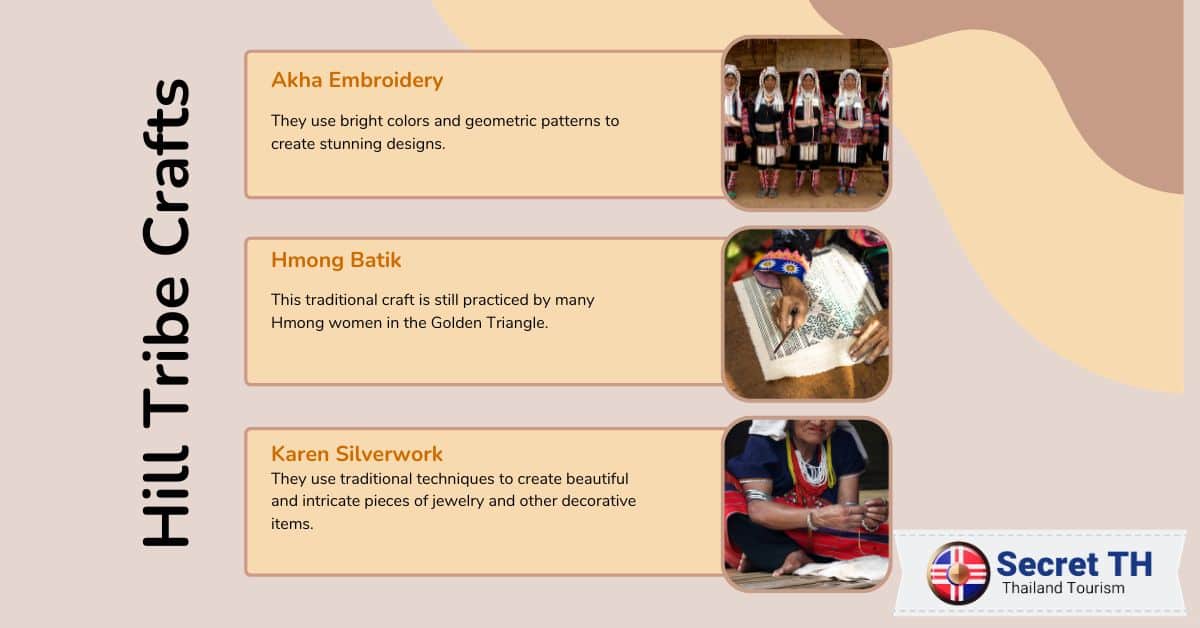The Golden Triangle in Thailand is a treasure trove of traditional arts. Renowned for its rich cultural heritage, the region boasts intricate wood carvings, delicate silk weaving, and unique pottery. The area’s artisans possess remarkable skills, passed down through generations, showcasing Thailand’s vibrant traditions in every piece. It is one of the country’s most fascinating regions, known for its rich history, diverse culture, and stunning natural beauty. Located at the meeting points of Thailand, Laos, and Myanmar, this area has a unique blend of influences from all three countries.
As we explore this fascinating area, we delve into the heart of Thailand’s artistic heritage, taking a closer look at the remarkable skills of the local artisans and their timeless creations. From elaborate wood carvings, and silk weaving that tells tales of old, to distinctive pottery that captures an age-old narrative — these are the traditional arts that define the Golden Triangle. This is a journey into a world where art isn’t just a product, it’s a way of life, a reflection of a culture steeped in history and diverse influences.
The Art of Lanna Kingdom
The Lanna Kingdom thrived from the 13th to 18th century. It was known for its distinctive arts and culture. One of the most prominent art forms from this period is Lanna-style painting. These intricate, hand-painted artworks often feature Buddhist mythology. They are rich in symbolism, with gold leaf applied on a lacquer background.
Additionally, Lanna’s traditional music has its unique charm. It features instruments like the ‘saw’, a Thai fiddle, and ‘khene’, a mouth organ. These art forms are not just relics of the past. They are vibrant parts of the present culture in the Golden Triangle, adding to its unique charm. Some of the most well-known traditional arts of Lanna include:

- Lanna Architecture: The distinctive architectural style of Lanna can still be seen in many temples and buildings in the Golden Triangle. These structures are characterized by their ornate design, intricate carvings, and vivid colors.
- Lanna Music and Dance: Lanna has a distinct type of music called “piphat” which is played using traditional instruments. This includes khene (bamboo mouth organ) and saw duang (two-stringed fiddle). Traditional Lanna dance performances often accompany this music. It has dancers wearing elaborate costumes and performing graceful movements.
- Lanna Textiles: The art of weaving is deeply ingrained in Lanna culture. The intricate patterns and designs are passed down through generations. Some of the most famous textiles are the “pha sin” (sarong) and “pha kiao” (shawl). They are still worn by women in the Golden Triangle today.
Hill Tribe Crafts
In the verdant highlands of the Golden Triangle, you’ll find a myriad of Hill Tribe communities. The tribes have their own unique crafts. These tribes, including Akha, Hmong, Karen, and Lisu, create vibrant handicrafts. They reflect their distinct cultures. The Akha are renowned for their silver jewelry, while the Hmong are known for their intricate embroidery.
The Karen tribe, on the other hand, specializes in woven baskets. The Lisu are famous for their colorful beadwork. These crafts not only serve practical purposes but also play a crucial role in preserving these tribes’ cultural identities and traditions.

Akha Embroidery: The Akha people are known for their intricate embroidery work. It can be seen in their traditional clothing and accessories. They use bright colors and geometric patterns to create stunning designs.
Hmong Batik: The Hmong people are skilled in the art of batik. A technique of using wax and dye to create intricate patterns on fabric. This traditional craft is still practiced by many Hmong women in the Golden Triangle.
Karen Silverwork: The Karen people are known for their silverwork. They are the major source of income for many families. They use traditional techniques to create beautiful and intricate pieces of jewelry and other decorative items.
Saa Paper
Another significant art form to be found in the Golden Triangle is the crafting of Saa paper. Originating from the mulberry tree, Saa paper is an age-old craft that reflects the deep respect for nature in Thai culture. The process involves boiling, pounding, and drying the bark to create a soft and durable paper. Known for its delicate texture and natural color, Saa paper is commonly used for making a variety of items ranging from notebooks and lanterns to decorative wall hangings and umbrellas. This traditional craft is a testament to the sustainable practices and artistic skills inherent to the region.

Tai Lue Weaving
The Tai Lue, a significant ethnic group in the Golden Triangle, are renowned for their exquisite weaving. Utilizing techniques handed down through generations, they create an array of textile products with complex geometric patterns, often incorporating symbols from nature and Tai Lue mythology.
Traditionally woven on a backstrap loom using cotton or silk, these textiles are vibrant, durable, and deeply rooted in the tribe’s cultural identity. Visiting a Tai Lue village, one can often hear the rhythmic clacking of looms, a testament to the continuation of this time-honored art form.

Weaving, Ceramics, and Other Traditions
Apart from the above-mentioned, several other traditional arts and crafts can be found in the Golden Triangle. The Yao people are skilled in weaving bamboo baskets and creating intricate silver jewelry. The Lisu tribe is known for their pottery and hand-painted ceramics, while the Lawa people excel in carving wood statues and traditional instruments.
These are just a few examples of the many traditional arts and crafts that can be discovered in Thailand’s Golden Triangle. The preservation of these practices is a reflection of the strong cultural identity and pride that exists in this region. Visitors to the Golden Triangle can experience these traditions firsthand by attending local markets, festivals, and workshops, where they can interact with craftsmen and learn about their craft.
By supporting these traditional arts, we can help ensure their continuation for generations to come. So next time you visit the Golden Triangle, take some time to explore and appreciate the rich traditional arts that make this region truly unique.

Conclusion
The traditional arts and crafts of the Golden Triangle are not just beautiful works of art, but they also hold significant cultural and historical value. These art forms have been passed down through generations. It continues to play an important role in preserving the region’s rich heritage. By learning about and supporting these traditions, we can help ensure their longevity.
We can appreciate the unique cultural identity of the Golden Triangle. So next time you find yourself in this enchanting region, take a closer look at the intricate patterns. Their vibrant colors and skilled craftsmanship make up its traditional arts.











